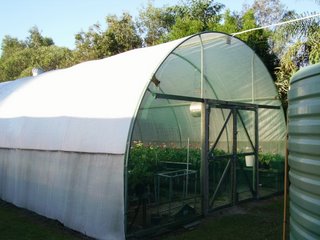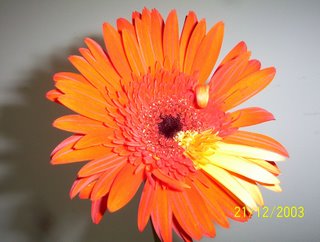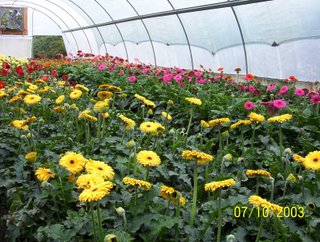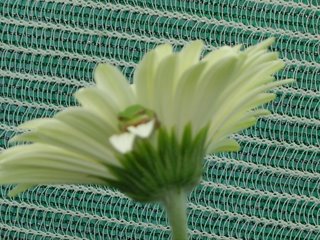Saturday, December 30, 2006
Roof Repair
We had a little rain - actually almost one inch on one occasion, but no damage done. I've had time to do some deleafing and fix up some of the plants that have grown wildly out of control.
We are still having problems with moths and they seem to laugh at the spraying. I think we are winning, but some days you'd wonder.
Sunday, December 17, 2006
Roof Repair
After weeks of mostly fine hot dry weather, the days after the new roof arrived hve been anything but. The guys were all set to do it today (Sunday 17th) and it is too windy to do so, with the chance that this weather will continue for a few days, and with high winds, it is causing us some concern. But there's not much we can do. Just wait it out and hope that all will be well.
The florists are pretty busy and this last week before Christmas they want red flowers for their Christmas arrangements. Thank goodness we have plenty of them!
Wednesday, November 29, 2006
Flowers from Monet's Fresh Flowers

Sunday, November 26, 2006
Storm damage
The flowers are taller
Friday, November 17, 2006
Frog in a Gerbera
Monday, November 13, 2006
The flowers are blooming again!
We are still having a little problem with mothers, and the Rutherglen bug hasn't completely gone, but there is a noticeable reduction in both.
My little green frog came out this morning. I'm sure there is more than one, but I only ever see one, and I "assume" that it is my one friendly frog who suns himself on one of the pink flowers.
Saturday, November 11, 2006
Dramatic Improvement
The improvement was almost immediate. Within a couple of days the plants looked healthier. Those that had a yellow tinge around their leaves took on a healthy green look, and the flower stems steadily grew taller. The quality of the flowers improved.
Now, less than two weeks since we found the cause of the problem, the flowers are spectacular. Indeed we had the best pick today – better than we have had for months, and the flower quality was excellent.
Even my resident frog must have been happy, as the little green fellow greeted me from one of the pale pink flowers.
Poor quality flowers in October
October was a poor month for the gerbera farm. Despite the warm weather, the flowers weren’t at their best. The stems were short, and a lot of the flowers were distorted. Our figures for 2005 showed the same downturn in October last year, so was it just a seasonal thing?
In any case we had the usual spring problems with bugs. Butterflies or moths got in, laid their eggs and produced a whole lot of grubs that ate their way into the leaves and flowers. They seemed to resist the constant spraying. Then the Rutherglen bugs came. The infestation of the latter was amazing. They were thick up the walls of the hot house, in the flowers and flew into our faces as we picked. We just couldn’t seem to get on top of them.
But why were the flowers less than perfect and the stems short? So we brought in our Horticultural Expert who initially couldn’t find the problem.
We now know. Because we are in the worst drought for somewhere between 100 and 1000 years (depending on which expert you read), we have tried to reduce our use of water. We had been told that we needed 30% run off, so that 70% of the water and nutrient remained in the pot, and the remainder was flushed away. Because of the drought, we felt that runoff was a waste and reduced the water. What we had indeed done was not allowed the chemicals/salts to be flushed from the plants and they collected around the roots of the plants choking them.
The solution? Use our precious water to flush out each plant, to dilute the salts. It was along and painstaking task, but the results were pretty dramatic.
Tuesday, September 26, 2006
Planting new "babies"
We fill each pot with the bark mixture and place them in their rows in the hot house. Then the drippers are placed in each pot - loosely at this time.
Then we prepare some trays and dishes. Each new plant is dipped in diazanon (we wear stong gloves to do this) and then in a Nutritech mixture, and then they sit in a tray until ready to put in the pots in the hot house.
We can do several hundred in an hour, or less if there are more than two of us working on it at the time.
Spring flush
We have ordered months before hand so we know what we have to do. Old plants are discarded - sold if we can manage it - and we prepare for the new plants.
Friday, September 15, 2006
Another odd flower
Long lasting

I checked and these flowers, although looking a little worse for wear have been in their vase for over two weeks now. They are on their "last legs" but it indicates how long they can last if kept properly. They do like dark glass vases (green bottle on this occasion) and regular fresh water. Now I haven't changed the water at all in two weeks and they have lasted. What if I had changed the water?............
Sunday, September 03, 2006
Spring blooms

We are a few days into spring and although the weather has been inclement (overcast and rain) the flowers are blooming. We are headed for the "spring flush" - a time when the flowers bloom at a fast rate. Which is good, as people like to brighten their homes in spring and generally the sales of flowers increase. It is a good time for us.
Wednesday, August 23, 2006
Odd bud
Sunday, July 16, 2006
Care of Cut flowers

We are regularly asked about the care of Gerberas as cut flowers. We know ours last a long time - but that is because they are freshly picked. Our florists get them often within hours of picking - whcih doesn't happen if they purchase from flower markets.
They love fresh water, and not much of it. You can see in this vase the water is only about 2 inches deep. There is no need to wire the flowers - just change the water every other day, clip 1/2 inche from the end of each stem, and put them in fresh water. Generally we are told that they prefer a dark vase - not a glass one as shown in this picture, but we use both. Some of the best shapes of vases are in clear glass these days. Make sure the vase is very clean when you first put the flowers in, and if any flower wilts, you can cut it off at the stem and put it in a shorter vase or float it. A drop of bleach might help too - as it is the bacteria that build up in the water and prevent the stem "sucking up the water" that is the problem.
Half flower

Sometimes there is damage done to the flower as it erupts from the crown. This flower, as you can see, has only developed on one side. Some petals have not materialised at all. It might be simply that when another flower was plucked from the plant it slightly disturbed the stem of this one, resulting in one half of the stem and flower not receiving the water and nutrient. Perhaps a bug has chewed at the base of the plant. Maybe there is no good reason. The flower is useless and ends up in our little pile of "seconds."
Friday, July 14, 2006
Hothouse

Our "hothouses" are two domes - with metal frames, covered in heavy plastic. Each end is enclosed with an open weave fabric. The plants grow on shelves each with their own irrigation spike that delivers measured amounts of water and nutrient and water at specific times. We can calculate exactly how much each plant receives. Large growers have much more sophisticated hothouses - with computers which collect data and automatically change the atmosphere, or water and nutrient usage based on the data collecated. Ours, is a much more unsophisticated operation - we monitor things ourselves and manually make changes to things.
White Gerbera
Sunday, June 25, 2006
Another of nature's mysteries.
Thursday, June 01, 2006
Gerbera Cups

There are several ways that growers prepare gerbera flowers for the market. Some growers use cardboard cards to transport their flowers. The flowers are placed in the specially made "cards". It does take time to prepare the flowers and there is of course a cost for the cards. At Gough Hill Farm we have chosen to use "gerbera cups" - specially made plastic cups protect the flower in transit. Each flower is placed stem first into the cup, and the stem pulled through so that the cup sits around the flower. There is a machine that does the work, but our farm is not big enough to make that a viable option. All flowers are "cupped" by hand. The cups cost around 3 cents each. We prefer to use this method as despite the fact that it is hand done, we can do it very quickly now and it does certainly protect the flower during deliver.
An unusual flower
Winter comes
What does happen to the flowers is that they slow down. Still lovely flowers but they take longer to mature. So we don't need to pick so often.
Florists at the moment are finding it difficult to get some flowers and as our production is down we have some disappointed customers. That's life.
Thursday, April 13, 2006
The weather
Quite a lot really. Although they are kept under a plastic tunnel, and consequently spared the ravages of wind and rain for the most part (some at either end may experience a little more of both than we'd prefer!), other weather patterns affect the Gerbera.
Humidity. Powdery mildew and Botrytis are two diseases that are brought on by humidity, and lack of fresh air circualting around the plants. It is our pattern to spray for botrytis on a regular basis. Once when we didn't spray often enough the whole crop of flowers had to be discarded. All had the tell-tale sign of the disease on the petals of the flower so were of no value to the florists.
Powdery mildew affects the leaves more than the flower. Once again, spraying when it appears is necessary. There are other ways, but we choose to spray.
Cloudy days. Now this makes a big difference, especially when the weather is cooler. Gerberas like warm, sunny days. The flowers just slow down so much when we have several cloudy days - and there is little we can do. Obviously production is down. Less flowers for the florists. Less money in the till.
Thursday, April 06, 2006
Gerberas in the Commonwealth Games Flowers.
The flowers were heliconias, and mini gerberas (Harley - a sprightly orange) which were surrounded by yellow "billy buttons", and an anthyrium on the outside of an extra-ordinary frame. The arrangement had to withstand rough handling by the competitors - it must not fall apart. As far as I saw it didn't.
We were tickled pink about the arrangement - they certainly weren't our Harley's in the Comm Game flowers but they are one of our favourites in our hot house.
Tuesday, April 04, 2006
Bugs and diseases
Currently we are fighting an attack by the "apple moth" that has found it's way in, laid some eggs and it's little offspring have found their way into many buds. The eat their way in, poop everywhere, and destroy the flower. As we pick we come across these damaged flowers, so pick them off, stomp on the flower to kill the grub, and keep up the spraying until it is all clear again.
Another bug that we have currently is red spider mite. These tiny pin head insects can be seen all over the leaves in particular, and sometimes create a fine net around a flower. More spraying to control them too.
We don't like spraying - but it is a fact of life, and we choose to use less toxic sprays on the plants. Sometimes we have little choice. Spray it must be.
Sunday, April 02, 2006
De-leafing - our rush to finish.
We do regular "de-leafing" - removing the dead decaying leaf litter that occludes the crown of the plant, as well as the mass of healthy leaves that overcrowd the adjacent plants.
One thing we do is regular "hair cuts" with hedge shears - removing all the leaves that hang into the walkways between the rows of plants, and then we get to - either with secateurs to cut away the excess leaves, or with our hands, pulling out the leaves that are no longer needed. It is a dirty back breaking job - but you can almost see the plants sighing with relief as they know that they can "breathe" easier.
I do an hour or so at a time - it IS backbreaking, and you then have to remove the wasted leaves from the hothouse.
We plan to de-leaf in the two hothouses in the next couple of weeks - before the really cool weather sets in.
Thursday, March 23, 2006
Two toned flowers

There are some Gerberas that are created to be two toned - but this one is one of the oddities that appear from time to time. I'd suggest that this orgage flower was created by using a yellow flower - anyway from time to time this particular plant would throw off one of these flowers with a small section of petals bright yellow, and the rest, as we would expect the orange colour.
Tuesday, March 21, 2006
Varieties

There are currently well over 2500 varieties of Gerbera. The home of Gerbera development is Holland - with large horticultural businesses dotted through the country. Each year the key players in Gerbera propogation release stunning catalogues that showcase their new varieties as well as the tried and tested popular varieties.
Growers throughout the world explore the catalogues, checking details (are they fast growers, prolific producers of flowers, suitable for hot or cold climates etc.) before ordering their new season's plants. It is some months before the new plants are ready - giving the grower time to remove old spent plants from their hothouse, and prepare for the new plants.
Monday, March 20, 2006
The Coldroom
We've had a couple of traumas with our cold room. One one occasion it froze all the flowers inside. Frozen gerberas are not pretty! We had it repaired, put the new pick of flowers in and again it froze.
Today as I was processing the flowers, I noted that the radio had gone off. We were listening to the progress of cyclone Larry in North Queensland. A fuse had "gone" so it was replaced. I noticed that the cold room was making an "unusual" sound and soon the fuse "went" again. It seems there is some problem with the compressor so as I write, we await our repairman again.
That's life.
Saturday, March 18, 2006
The Hothouse...

Is a huge plastic dome - with metal frame the plastic sheeting is stretched over the frame with special "petticoat" of white shadecloth. The plastic does wear and needs replacement every few years - so far our second hand ones have held but we look at the occasional tear or damage and wonder how long they will stand steadfast. In summer the roof of the hothouse is coated with special white paint, which creates a somewhat eerie atmosphere, but helps protect the plants from the hot overhead sun, and at the same time seems to encourage them the stems to grow taller. We have a door at one end, and big ceiling fans to circulate the air are suspended from the roof.
God's little mysteries.
Happy Flowers
When we pick the flowers we often have what we call "Seconds" - flowers that for one reason or another are not suitable for the market. Perhaps the flower has a smiley face instead of a round centre, a double header (photos of these will appear in this blog over time), or the flower is not mature enough, or too mature. We give these away. The alternative is to throw them away - but we choose to give them.
It is pure bliss to see the enjoyment these flowers have on people. Seconds? We seem to be the only ones that notice that these flowers have been created with a little blemish.
Friday, March 17, 2006
Where do Gerberas come from.
There is a website which states that the Gerbera is also native to Tasmania. The only Tasmania I can find in a World Atlas, is the southernmost state of Australia, and I also have a letter from the Tasmanian Botanical Gardens stating that the Gerbera definitely is NOT a native of Tasmania. I think even commercial flower growers would have challenges growing the flower in that state without the aid of atmospheric controlled hot houses - a very expensive option. The Website is Gerbera.com
One of my favourite things............................

This is one of my all time favourite gerberas. I use this photo on my business cards and letterheads for my business (The Official Biographer). I also have two pots of it growing at home and currently one of the blooms is in a vase beside the computer.
(The Official Biographer is my business - writing of life stories)
Weather is cooling down
Others that love the hot summer days are "having a rest" right now. We do need to get rid of excess foliage right now - hopefully we will have completed this major task by the end of April.
Monday, March 13, 2006
Our first pick
It was a few weeks before we had the work room ready for action, and the cold room in place, and plants started to produce in larger quantities.
We have learned so much since those days of taking one step at a time, or two steps forward and one step back again.
Sunday, March 12, 2006
The day the truck got bogged.
The truck was HUGE and there were a team of "volunteers" to help. They said they had never worked so hard. They had to carry pots of stones to the truck, pack them in, and go back and do it all again. The weather had been poor, and it rained, and somewhere along the way the truck got bogged.
Eventually it arrived at the farm - and it all had to be unloaded. The guys certainly enjoyed their beers at the end of the day, and from all accounts slept very well that night, and had aching muscles for days afterwards.
Bit by bit the farm was taking shape.
Saturday, March 11, 2006
Work continued
We had purchased part of an other hothouse, in a buy that included plants, pots, medium, and an assortment of things that we might need.
We had purchased from two people - one the hushand had apparently absconded and the wife just wanted to get rid of her other burden. The other was sad - the husband had passed away, so the wife was keen to get her life back in order without his gerbera farm. It was of course to our advantage, as things were cheaper.
But our husbands put in many hours of work in preparation for the big day when the plants would arrive.
Getting started
I often wonder if we'd known at the time how time consuming and expensive it all would be, if we would have gone ahead and done it.
We had a meeting of the four of us - and thought we had considered everything that needed to be researched. However, each week, there was more to learn, more money to spend.
In the end we spent far less than was in the material that we received from the industry papers. If we'd have seen those figures we'd have bailed out early. We were lucky - with the two guys willing and able to do a lot of the work themselves, plus an odd set of extraordinary luck, we did it all with less money than the experts predicted.
Friday, March 10, 2006
A frog on a Gerbera

What a surprise! We know there are frogs around the property, but we seldom see them in the hothouse. On this morning we found a little green tree frog resting in the petals of one of the white flowers. I always carry my camera with me - so I rushed to the car to get it, with my fingers crossed, hoping he/she would not leave before I recorded it. Funnily enough he hung on even after the flower was picked and he was given a gentle nudge to move on. Enjoy.
Thursday, March 09, 2006
The Next Chapter

Just over three years ago (December 2002) our second granddaughter was born, and around that time my husband and I were guests at a 45th Wedding Anniversary Party and we caught up with old acquaintances at the party. We chatted about our lives and it turned out that the friends (husband and wife) had just started a Gerbera farm on their property at Maleny, in the Sunshine Coast, north of Brisbane, Queensland.
RS spoke about his venture with enthusiasm. Some short time later we told the story to our daughter. As she and her husband had not long moved to a property with 2 1/2 acres, an interest sparked. Now at this point the story gets messy. Our daughter believes that I "encouraged" the idea to germinate that we create a Gerbera farm on the property. I believe that I created the idea to develop, but at no time did I every think that we would do it.
Some days later there was animated discussion about the possibilities - and after Christmas, our two menfolk went off to do research on other Gerbera farms.
By early 2003 we had decided to go into business - and the Gough Hill Gerbera Farm was born.
The Wedding
The tables at the reception were also decorated with Gerbera's - quite a spectacular floral display, thanks to Aunty Chris.
That was the beginning of the love affair with this colourful happy flower.
Wednesday, March 08, 2006
The Love of Gerberas
The flower mostly seen in gardens is close to the original found in Africa, but over the years thousands of hybrids have been developed. The pale pinks, and muted yellows and red with spikey petals whilst still poular in home gardens are not the plants and flowers now seen in the commercial gerbera growers of the world.
In this blog will be various stories of the history of the gerbera, and the story of the Gough Hill Farm in Brisbane, Australia.






